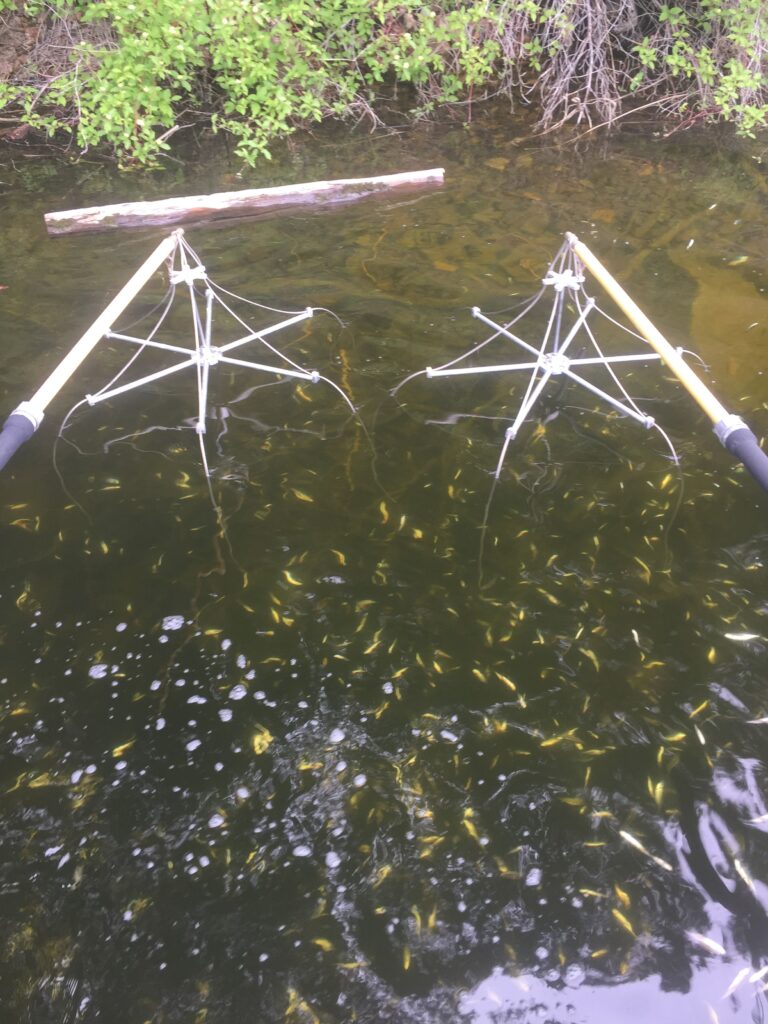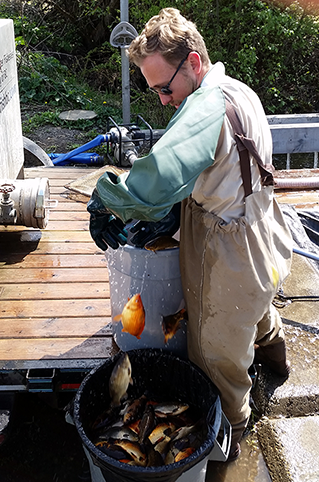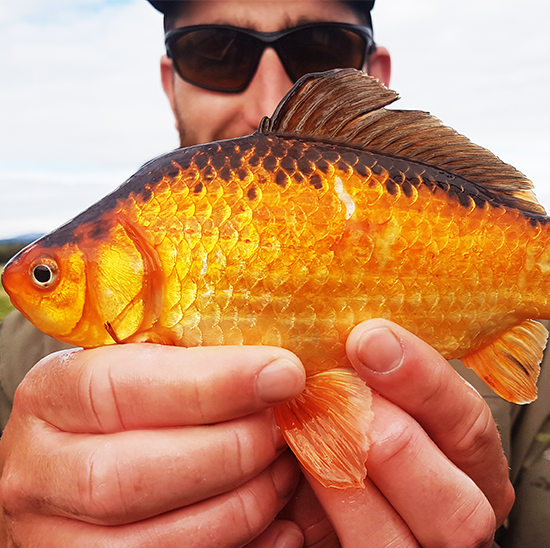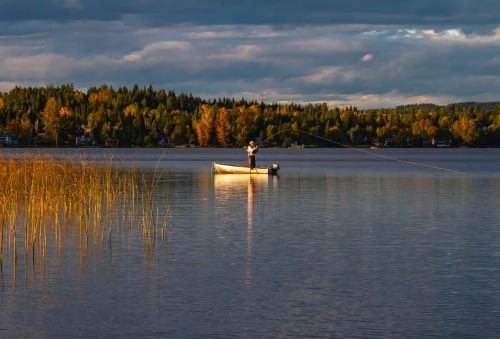Boat electroshocking is not a new tool for fisheries. It is commonly used in other jurisdictions to survey fish populations. However, its recent application in B.C. is a novel approach to reduce numbers of competing or invasive fish species that may be impacting rainbow trout and their habitats.
Electroshocking emits an electrical current through the water which runs between a cathode and an anode. This current can be manipulated to selectively target fish according to size. When the current is applied, fish may be stunned temporarily, instantly killed, or attracted to the anode where they can be scooped out of the water. In the case of boat electroshocking, the aluminum hull of a boat is the cathode; anodes are mounted on short outrigger poles in the bow, and can be raised and lowered into the water.
The Paul Lake shiner story
Paul Lake is a tiny jewel found about 20 kilometres northeast of Kamloops. It has much to offer – accessibility, facilities, and great boat fishing for rainbow trout. It also has a plethora of redside shiners.
Introduction of redside shiner to Paul Lake
Native to British Columbia, the redside shiner is a small minnow found in many watersheds. In fact, it is the most commonly found minnow in the province. Records indicate that this fish was introduced into Paul Lake around 1945; before this time, the lake had only rainbow trout. While shiners can contribute to the trout’s diet in this lake, these minnows in large numbers can also be significant competitors with trout for invertebrate prey like insects and small crustaceans.
Conditions that favour shiners can impact the quality of trout fisheries. The lake was treated in the early 1960s to create a monoculture rainbow trout fishery, but shiners later moved back into the lake from upstream Pinantan Lake, which was never treated.
Favourable conditions lead to redside shiner population explosion
In the early 2000s, a combination of high spring waters followed by summer droughts (intensified by water removals) led to increased natural rainbow trout production in the lake. These conditions also created a highly favourable environment for redside shiners, and its population exploded. It is thought that the stocking of large numbers of trout fry at the time, combined with these conditions, resulted in a population of stunted rainbow trout that were unable to prey upon or compete with the large shiner population. The imbalance between the two fish species has persisted ever since, preventing the recovery of the high-quality rainbow trout fishery for which Paul Lake had been known. With the decline in fishing quality, angler interest in Paul Lake has since waned (see graph below).


Electroshocking to reduce redside shiner population
Provincial fisheries biologists, anglers, angling clubs, and local residents were all keen to restore the trout fishery to its former status. After much discussion, Gene Tisdale (long-time Paul Lake resident, and proprietor of Tisdale Environmental Consulting) convinced fisheries biologists in Kamloops to test out a novel approach to reduce the large shiner population within the lake: boat electroshocking. First, water conservation measures were implemented to improve trout rearing conditions, and then, beginning in 2017, Tisdale Environmental Consulting began electroshock “therapy” to deplete the numbers of mature shiners. This activity was planned for four years, with the idea of reducing shiner spawners over successive years to a level where rainbow trout could increase in size, feed on shiners to keep their numbers in check, and restore the balance in the lake.
To date, the technique appears to be highly effective. Current estimates suggest that 95% of the mature shiner population has been eliminated. While more time is required to evaluate the recovery of the rainbow trout population, the early signs are positive, including the return of red-coloured flesh in young trout (indicative of freshwater shrimp in their diet) as well as the presence of larger trout in anglers’ catches. Greater numbers of swallows and other insectivorous birds have also been noted by the electroshocking crew. Monitoring for success over the longer term will be continued, with the hope that the former glory of Paul Lake’s trout fishery will be restored for anglers to enjoy in the years to come.
Project funding
The Highland Valley Enhancement Fund continues to be the major sponsor of this shock-treatment initiative. However, the Kamloops and District Fish and Game Club has also contributed funds, along with significant in-kind contributions of time and equipment by Tisdale Environmental Consulting. The Freshwater Fisheries Society of BC is also pleased to contribute to funds to further support this work.
The Dragon Lake goldfish story
By all accounts, the number of goldfish seasonally scooped out of Dragon Lake is impressive. If you fish this lake, chances are you’ve seen videos of concerned locals dumping nets full of bright orange fish on the shoreline. It’s hard to believe this biomass of goldfish aren’t impacting the popular rainbow trout fishery in the lake.
With its close proximity to Quesnel, Dragon Lake is a high-use waterbody in the heart of the Cariboo. Anglers hold this lake in high esteem for its trophy-sized rainbow trout. It is also a key brood lake, rearing the Blackwater strain of rainbow trout for the provincial lake stocking program.
Introduction of goldfish in Dragon Lake
Goldfish started showing up in Dragon Lake about 10 years ago. Goldfish are not native to B.C., or even to North America. However, this hardy carp species can put up with almost any water conditions. The productive environment in Dragon Lake, with its prolific vegetated shallows, makes for suitable goldfish habitat.
Why are goldfish here? Quite possibly, they started off as someone’s unwanted pets. Their numbers appear to have increased rapidly. Recent fish sampling has found multiple year-classes with large, older fish up to a foot in length showing up, suggesting that these fish are now well established.
With goldfish identified in at least 10 new lakes in B.C. over the past decade, this is becoming an increasingly challenging problem. While goldfish don’t eat trout, they share similar dietary preferences, creating a potential for food competition. And since they root around in sediment, stirring up the bottom and dislodging aquatic vegetation, goldfish are also notorious habitat destroyers.


Given the success observed in Paul Lake, provincial fisheries biologists are keen to try boat electrofishing of Dragon Lake goldfish. The hardiness of goldfish, combined with the complexity of the lake itself, make other options exceptionally more expensive. Shocking enables targeting congregations of spawners in the shallows. One drawback is the need to repeat the shock therapy periodically to keep the population at bay. At present, since it avoids chemical use (allowing ongoing access for lake users), it is the most viable option. The Society is supporting a pilot study to test the effectiveness of this technique to deal with goldfish infestations.
Author: Sue Pollard, Freshwater Fisheries Society of BC
